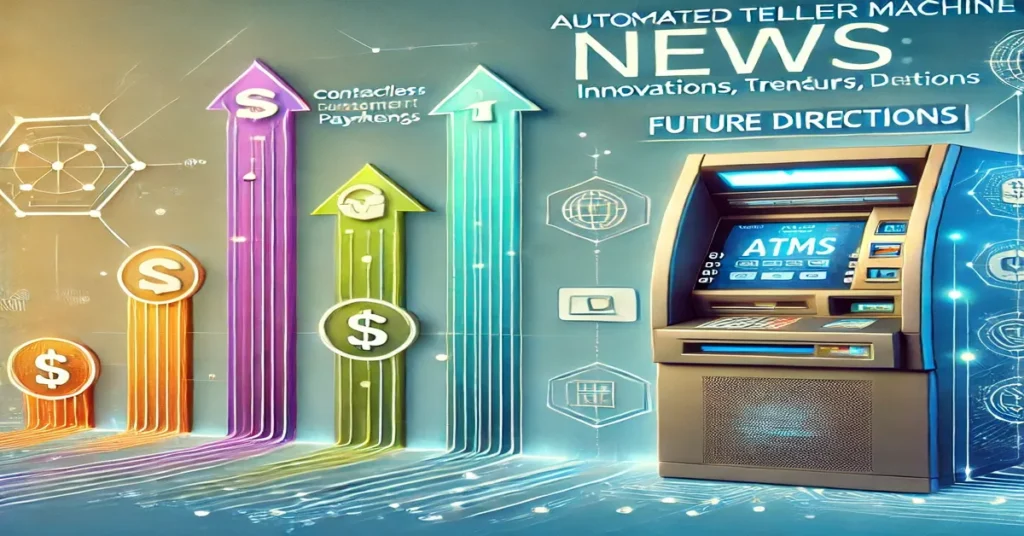Automated Teller Machines (ATMs) have revolutionized the way we access cash and conduct banking transactions. Since their introduction in the late 1960s, ATMs have evolved significantly, becoming integral to the banking experience. With advancements in technology and changes in consumer behavior, the automated teller machine news ATM landscape is continuously changing. This article will explore the latest news and developments in the ATM industry, including innovations, trends, security challenges, and future directions.
The Evolution of ATMs
A Brief History
The first ATM was installed in 1967 at a Barclays bank in London, allowing customers to withdraw cash using a special card. This innovation paved the way for automated banking services, offering convenience to users who no longer needed to visit a bank branch during working hours.
In the years that followed, ATMs began to proliferate across the globe. The introduction of cards with magnetic stripes in the 1970s allowed for more secure transactions and set the stage for the development of various features, such as balance inquiries and fund transfers.
Technological Advancements
Over the decades, ATMs have undergone significant technological advancements:
- Cardless Transactions: Recent innovations allow users to withdraw cash without a physical card. Customers can use their mobile banking app to generate a QR code or a one-time PIN, which can be scanned at the ATM.
- Multi-Functional ATMs: Modern ATMs offer more than just cash withdrawals. Many machines now allow users to deposit cash and checks, transfer funds, pay bills, and even purchase prepaid cards.
- Touchscreen Interfaces: The introduction of touchscreen technology has improved user experience, making it easier to navigate menus and access various functions.
- Enhanced Security Features: With the rise in ATM fraud, security measures have become more sophisticated. Biometric authentication, such as fingerprint and facial recognition, is becoming more common, along with enhanced encryption methods.
Current Trends in the ATM Industry
1. Rise of Contactless Transactions
The COVID-19 pandemic accelerated the demand for contactless banking solutions, including ATMs. Many banks have responded by introducing cardless cash withdrawal options, allowing customers to complete transactions using their smartphones. This trend is expected to continue as consumers prioritize hygiene and convenience.
2. Integration with Digital Banking
As digital banking becomes increasingly popular, ATMs are being integrated into broader banking ecosystems. Many banks now offer services that link traditional ATM functions with their online and mobile banking platforms. This integration enhances the customer experience and provides seamless access to financial services.
3. Focus on User Experience
Financial institutions are prioritizing user experience when it comes to ATM design. This includes improving the physical design of machines, enhancing user interfaces, and providing personalized services based on customer data. By focusing on user experience, banks aim to increase customer satisfaction and loyalty.
4. Sustainability Initiatives
As environmental concerns grow, the ATM industry is taking steps towards sustainability. This includes energy-efficient machines, eco-friendly materials, and recycling programs for old machines. Some banks are even exploring solar-powered ATMs in remote areas.
5. Cryptocurrency Integration
The rise of cryptocurrencies has led to a new trend in the ATM industry: cryptocurrency ATMs. These machines allow users to buy and sell cryptocurrencies like Bitcoin using cash or credit cards. As cryptocurrencies gain mainstream acceptance, more financial institutions are considering integrating these features into their ATMs.
6. Security Enhancements
With the increase in ATM-related fraud, banks are investing heavily in security technologies. This includes anti-skimming devices, improved encryption protocols, and advanced monitoring systems to detect suspicious activities in real-time.
Innovations in ATM Technology
1. AI and Machine Learning
Artificial Intelligence (AI) and machine learning are transforming the ATM landscape. These technologies enable banks to analyze customer behavior and transaction patterns, allowing for better service customization and fraud detection. AI can also help optimize cash management by predicting cash needs based on transaction trends.
2. Biometric Authentication
Biometric authentication, such as fingerprint scanning and facial recognition, is gaining traction in the ATM sector. These methods provide an additional layer of security, making it harder for fraudsters to access accounts. Biometric ATMs are especially popular in regions where identity theft is a significant concern.
3. Mobile Integration
ATMs are increasingly integrating with mobile banking applications. Users can now initiate transactions from their smartphones, receive QR codes for cash withdrawals, and even deposit checks using their mobile devices. This integration enhances convenience and aligns with the trend toward digital banking.
4. Smart ATMs
Smart ATMs are equipped with advanced technology that allows them to offer a wider range of services. These machines can provide financial advice, assist with loan applications, and even facilitate insurance purchases. The goal of smart ATMs is to create a more interactive and comprehensive banking experience.
5. Remote Management Systems
Many banks are adopting remote management systems for their ATMs. These systems allow financial institutions to monitor ATM performance, track cash levels, and receive alerts for maintenance issues in real-time. This proactive approach reduces downtime and improves operational efficiency.
6. Enhanced User Interfaces
The user interface of ATMs is becoming more intuitive and user-friendly. Touchscreen technology, simplified navigation, and multi-language options enhance the customer experience. Many ATMs are also incorporating video tutorials to guide users through transactions.
Challenges Facing the ATM Industry
1. Fraud and Security Threats
Despite advancements in security technology, automated teller machine news ATMs remain targets for fraudsters. Skimming, card trapping, and other forms of theft pose significant challenges for the industry. Financial institutions must continuously adapt their security measures to combat these threats.
2. Regulatory Compliance
ATMs are subject to various regulations and compliance standards, which can vary by region. Keeping up with these requirements can be challenging for financial institutions, particularly as regulations evolve in response to new technologies.
3. Maintaining Cash Availability
Ensuring that ATMs are adequately stocked with cash can be a logistical challenge, especially in high-traffic areas. Banks must develop efficient cash management strategies to balance the need for accessibility with operational costs.
4. Technological Integration
As the ATM industry evolves, integrating new technologies can be complex. Financial institutions must invest in training for staff, update existing systems, and ensure that new technologies are compatible with their infrastructure.
5. Market Competition
With the rise of digital banking and mobile payment solutions, ATMs face increasing competition from alternative banking methods. Financial institutions must find ways to differentiate their ATM services and offer value to customers.
Future Directions for the ATM Industry
1. Increased Personalization
The future of automated teller machine news ATMs lies in personalization. By leveraging customer data, banks can tailor services and recommendations to individual users, enhancing the overall banking experience.
2. Continued Integration of Technology
The integration of AI, biometrics, and mobile technology will continue to shape the future of ATMs. As technology advances, ATMs will become smarter and more capable of providing a wider range of services.
3. Focus on Customer Experience
As competition in the banking sector intensifies, a focus on customer experience will be paramount. Banks will need to invest in user-friendly designs, personalized services, and innovative features to attract and retain customers.
4. Global Expansion of Cryptocurrency ATMs
As cryptocurrencies gain popularity, the number of cryptocurrency ATMs is expected to rise. This expansion will allow users to buy and sell cryptocurrencies with greater ease, further integrating them into the mainstream financial landscape.
5. Enhanced Security Protocols
With ongoing threats to automated teller machine news ATM security, the industry will need to continually evolve its security protocols. This includes adopting new technologies, improving monitoring systems, and educating users about best practices for protecting their accounts.
6. Sustainability Initiatives
Environmental concerns will drive the ATM industry to adopt more sustainable practices. Solar-powered ATMs, energy-efficient models, and eco-friendly materials will become more common as banks seek to reduce their carbon footprint.
Conclusion
The world of automated teller machine news (ATMs) is dynamic and continually evolving. As technology advances and consumer preferences change, the ATM industry must adapt to meet new challenges and opportunities. Investment in innovation, security, and user experience will be crucial for financial institutions looking to thrive in this competitive landscape.
InvestmentTotal.com aims to keep readers informed about the latest trends and developments in the ATM sector, empowering them to make informed decisions about their banking options. Whether you’re a consumer looking to understand more about the ATMs you use or a financial professional seeking insights into industry trends, staying informed is key to navigating the future of automated banking.
FAQs
1. What is an Automated Teller Machine (ATM)?
An ATM is a banking device that allows users to perform financial transactions such as withdrawing cash, checking balances, and depositing funds without the need for a bank teller.
2. How have ATMs evolved over the years?
ATMs have evolved from simple cash withdrawal machines to multifunctional devices that offer services like deposits, bill payments, and account inquiries, incorporating advanced technologies like biometrics and mobile integration.
3. What are some security features of modern ATMs?
Modern ATMs include features such as cardless transactions, biometric authentication, anti-skimming devices, and real-time monitoring to enhance security and protect against fraud.
4. Can I use my ATM card internationally?
Many ATM cards can be used internationally, but users should check with their bank regarding fees and availability in foreign countries before traveling.
5. What should I do if my card gets stuck in an ATM?
If your card is stuck in an ATM, contact the bank or service provider immediately for assistance. They can help you recover your card and address any security concerns.
6. How do cryptocurrency ATMs work?
Cryptocurrency ATMs allow users to buy or sell cryptocurrencies using cash or debit/credit cards. They function similarly to traditional ATMs but are specifically designed for cryptocurrency transactions.






